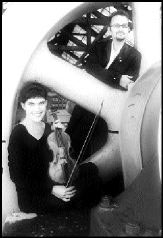SEATTLE BAROQUE
Benaroya Recital Hall, Oct. 26
next performance Nov. 22
THE PERIOD-INSTRUMENT movement at its most persuasive was never an end. It was a means of rediscovering a millennium’s worth of music before Beethoven—music that excited and moved the people of its time, and which could do so again with the proper approach.
Seattle Baroque’s been holding aloft this banner since 1994. Last weekend’s concert, Madness, brought together a concerto by Georg Muffat, “Delirium Amoris,” and a Handel cantata with the same subtitle in Italian, “Delirio Amoroso.” Baroque composers relished the mood swings offered by this theme. Muffat rendered amorous delirium with every contrast of texture, tempo, and volume he could muster; Handel, in this tale of a shepherdess mourning the death of an indifferent shepherd, packed grief, anger, and blissed-out consolation into a half-hour showcase for soprano and small orchestra. In last weekend’s performance, Ellen Hargis sang with a stunning palette of color—full vibrato to “white” non-vibrato and every nuance in between, deployed with wondrous control and a keen dramatic sense.
This close alliance between instrumental music and operatic technique was the program’s subtext. Virtuosity, whether instrumental or vocal, was what the 18th century used to heighten musical expressiveness, in lieu of elements more commonly available to later composers, such as lavish orchestral color or sensuous chromatic harmony (though pioneering experiments in these areas aren’t hard to find in baroque music). Seattle Baroque keyboardist Byron Schenkman points out that Handel, for example, “spent his life in showbiz,” and even the concert opener, the Sonata op. 5 no. 4—a suite of dances Handel borrowed from his own operas—has theater connections.
Vivaldi’s Recorder Concerto in G offered a further example. In romantic concertos, the soloist became the dramatic “protagonist,” outdoing and subduing an entire orchestra with superior skill. But in baroque concertos like this one, the soloists seem to take on a stage persona—in this case, a particularly ecstatic nightingale (more “madness”). Judith Linsenberg played the leaping, wayward solo part with an infectious verve.
Seattle Baroque’s next concert, Nov. 22, will also explore instrumental/vocal interplay, with sonatas and fantasies based on popular and art songs. It’ll be an anniversary celebration for Schenkman and his co-director, violinist Ingrid Matthews, who both arrived 10 years ago to plant the seed for Seattle Baroque, and who’ve helped create one of the country’s most vital early-music scenes.








